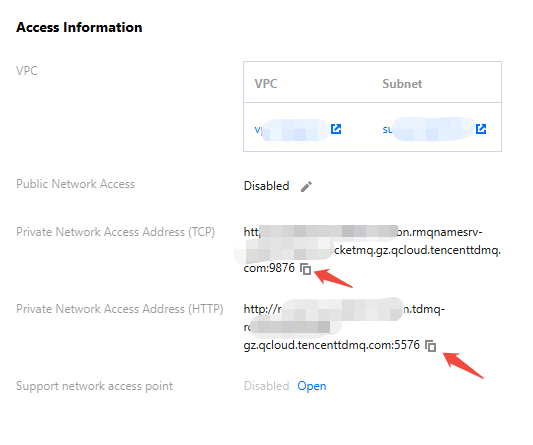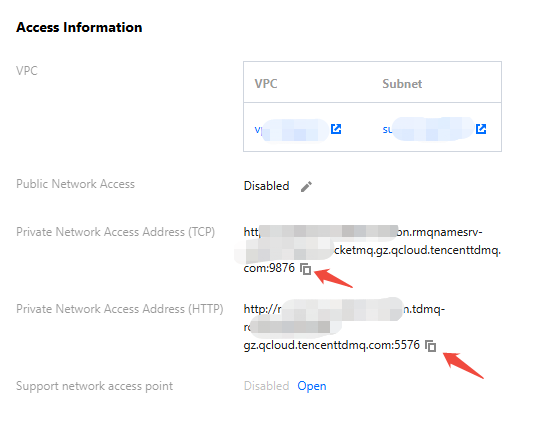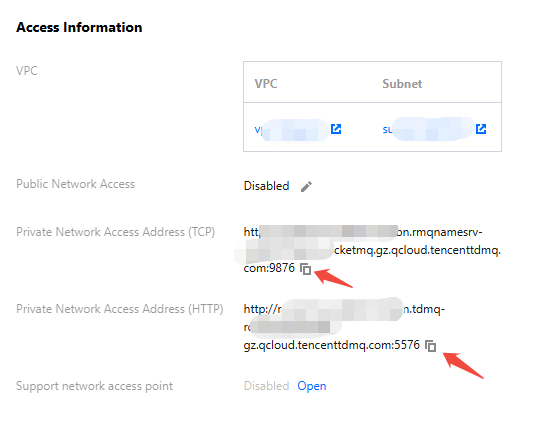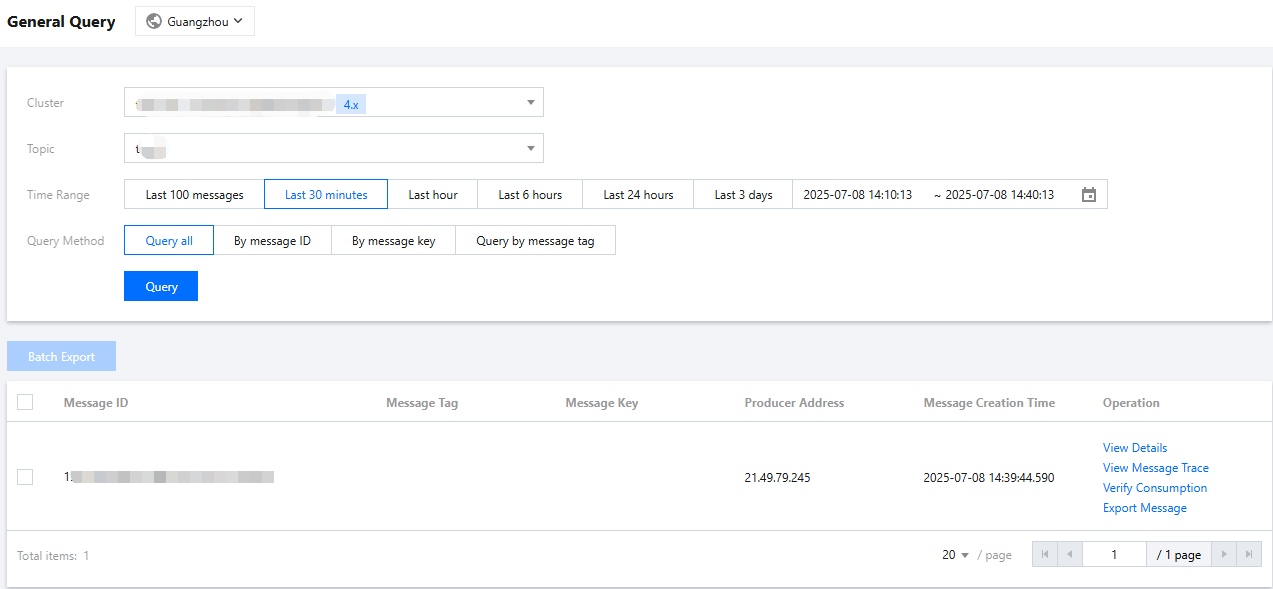Cluster usage for 4.x Send and receive ordinary messages with 4.x SDK
Last updated: 2025-07-24 10:23:21
Cluster usage for 4.x Send and receive ordinary messages with 4.x SDK
Last updated: 2025-07-24 10:23:21
Overview
TDMQ for RocketMQ supports multiple language SDKs to send and receive different types of messages. This document uses Java SDK calls as an example to introduce the operation process of sending and receiving ordinary messages by connecting to TDMQ for RocketMQ server via the 4.x SDK.
Prerequisites
You have created the required resources as instructed in Resource Creation and Preparation.
Directions
Step 1. Install the Java dependent library
Introduce dependencies in a Java project and add the following dependencies to the
pom.xml file. This document uses a Maven project as an example.Note:
The dependency version must be v4.9.3 or later.
<!-- in your <dependencies> block --><dependency><groupId>org.apache.rocketmq</groupId><artifactId>rocketmq-client</artifactId><version>4.9.3</version></dependency><dependency><groupId>org.apache.rocketmq</groupId><artifactId>rocketmq-acl</artifactId><version>4.9.3</version></dependency>
Step 2. Produce messages
1. Create message producers
// Instantiate the message producersDefaultMQProducer producer = new DefaultMQProducer(namespace,groupName,new AclClientRPCHook(new SessionCredentials(accessKey, secretKey))// ACL permission);// Set the NameServer addressproducer.setNamesrvAddr(nameserver);// Start the producer instancesproducer.start();
Parameter | Description |
namespace | Namespace name, which can be copied on the Namespace page in the console. If you use a 4.x generic cluster, fill in the cluster ID here.  |
groupName | Producer group name, which can be copied under the Group tab on the Cluster page in the console. |
nameserver | Cluster access address, which can be copied under the Network module on the cluster’s basic information page in the console.  |
secretKey | Role name, copied from the SecretKey column on the role management page in the console.  |
accessKey | Role token, copied from the AccessKey column on the role management page in the console. |
2. Send messages
Messages can be sent in the sync, async, or one-way mode.
for (int i = 0; i < 10; i++) {// Create a message instance and set the topic and message contentMessage msg = new Message(topic_name, "TAG", ("Hello RocketMQ " + i).getBytes(RemotingHelper.DEFAULT_CHARSET));// Send the messageSendResult sendResult = producer.send(msg);System.out.printf("%s%n", sendResult);}
Parameter | Description |
topic_name | Copy the Topic name from the Topic management page in the console.  |
tag | A parameter used to set the message tag. |
// Disable retry upon sending failuresproducer.setRetryTimesWhenSendAsyncFailed(0);// Set the number of messages to be sentint messageCount = 10;final CountDownLatch countDownLatch = new CountDownLatch(messageCount);for (int i = 0; i < messageCount; i++) {try {final int index = i;// Create a message instance and set the topic and message contentMessage msg = new Message(topic_name, "TAG", ("Hello rocketMq " + index).getBytes(RemotingHelper.DEFAULT_CHARSET));producer.send(msg, new SendCallback() {@Overridepublic void onSuccess(SendResult sendResult) {// Logic for message sending successescountDownLatch.countDown();System.out.printf("%-10d OK %s %n", index, sendResult.getMsgId());}@Overridepublic void onException(Throwable e) {// Logic for message sending failurescountDownLatch.countDown();System.out.printf("%-10d Exception %s %n", index, e);e.printStackTrace();}});} catch (Exception e){e.printStackTrace();}}countDownLatch.await(5, TimeUnit.SECONDS);
Parameter | Description |
topic_name | Copy the Topic name from the Topic management page in the console.  |
tag | A parameter used to set the message tag. |
for (int i = 0; i < 10; i++) {// Create a message instance and set the topic and message contentMessage msg = new Message(topic_name, "TAG", ("Hello RocketMQ " + i).getBytes(RemotingHelper.DEFAULT_CHARSET));Send one-way messagesproducer.sendOneway(msg);}
Parameter | Description |
topic_name | Copy the Topic name from the Topic management page in the console.  |
tag | A parameter used to set the message tag. |
Note:
Step 3. Consume messages
1. Create a consumer
TDMQ for RocketMQ supports two consumption modes: push and pull.
// Instantiate the consumerDefaultMQPushConsumer pushConsumer = new DefaultMQPushConsumer(namespace,groupName,new AclClientRPCHook(new SessionCredentials(accessKey, secretKey))); //ACL permission// Set the NameServer addresspushConsumer.setNamesrvAddr(nameserver);
Parameter | Description |
namespace | Namespace name, which can be copied on the Namespace page in the console.If you use a 4.x generic cluster, fill in the cluster ID here.  |
groupName | Producer group name, which can be copied under the Group tab on the Cluster page in the console. |
nameserver | Obtain the cluster access address from the access information module on the console cluster basic information page.  |
secretKey | Role name, copied from the SecretKey column on the role management page in the console.  |
accessKey | Role token, copied from the AccessKey column on the role management page in the console. |
// Instantiate the consumerDefaultLitePullConsumer pullConsumer = new DefaultLitePullConsumer(namespace,groupName,new AclClientRPCHook(new SessionCredentials(accessKey, secretKey)));// Set the NameServer addresspullConsumer.setNamesrvAddr(nameserver);// Specify the first offset as the start offset for consumptionpullConsumer.setConsumeFromWhere(ConsumeFromWhere.CONSUME_FROM_FIRST_OFFSET);
Parameter | Description |
namespace | Namespace name, copied from the namespace page in the console. If you use a 4.x generic cluster, fill in the cluster ID here.  |
groupName | Producer group name, which can be copied under the Group tab on the Cluster page in the console. |
nameserver | Obtain the cluster access address from the access information module on the console cluster basic information page.  |
secretKey | Role name, copied from the SecretKey column on the role management page in the console.  |
accessKey | Role token, copied from the AccessKey column on the role management page in the console. |
Note:
2. Subscribe to messages
The subscription modes vary by consumption mode.
// Subscribe to a topicpushConsumer.subscribe(topic_name, "*");// Register a callback implementation class to process messages pulled from the brokerpushConsumer.registerMessageListener((MessageListenerConcurrently) (msgs, context) -> {// Message processing logicSystem.out.printf("%s Receive New Messages: %s %n", Thread.currentThread().getName(), msgs);// Mark the message as being successfully consumed and return the consumption statusreturn ConsumeConcurrentlyStatus.CONSUME_SUCCESS;});// Start the consumer instancepushConsumer.start();
Parameter | Description |
topic_name | Copy the Topic name from the Topic management page in the console.  |
"*" | If the subscription expression is left empty or specified as asterisk (*), all messages are subscribed to. tag1 || tag2 || tag3 means subscribing to multiple types of tags. |
// Subscribe to a topicpullConsumer.subscribe(topic_name, "*");// Start the consumer instancepullConsumer.start();try {System.out.printf("Consumer Started.%n");while (true) {// Pull the messageList<MessageExt> messageExts = pullConsumer.poll();System.out.printf("%s%n", messageExts);}} finally {pullConsumer.shutdown();}
Parameter | Description |
topic_name | Copy the Topic name from the Topic management page in the console.  |
"*" | If the subscription expression is left empty or specified as asterisk (*), all messages are subscribed to. tag1 || tag2 || tag3 means subscribing to multiple types of tags. |
Step 4. View consumption details
After sending the completion message, you will get a message ID. You can query the just-sent message, as well as its details and path, on the console under Message Query > Comprehensive Query.

Was this page helpful?
You can also Contact Sales or Submit a Ticket for help.
Yes
No
Feedback

